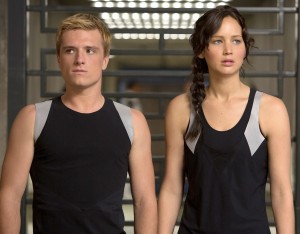Catching Fire improves on first Hunger Games film
It’s one of the unfortunate facts of film: sequels are usually worse than their predecessors. The writers responsible usually have trouble continuing the storylines that made the first film so interesting and the same spark just isn’t there. On rare occasion, however, the opposite happens — the creative team from the original film is changed, more resources are funneled into the sequel and all of a sudden, the sequel not only measures up to the original, but actually builds upon it to create something even more impressive. This was certainly the case two weeks ago with the release of Thor: The Dark World, and it seems lightning struck twice with the release of The Hunger Games: Catching Fire.

Good looking out · Academy Award winning actress Jennifer Lawrence (right) reprises her role as Katniss Everdeen and Josh Hutcherson (left) plays love interest Peeta Mellark in The Hunger Games: Catching Fire. – Photo courtesy of Murray Close
This sequel sees a new director and a handful of new faces thrown into the mix. Gone is Gary Ross, the director of the original, and gone with him is his overuse of shaky cameras. In his place, we find Francis Lawrence, director of I Am Legend and Constantine. Lawrence signed up to do Catching Fire as well as the next two sequels, Mockingjay — Part 1 and Mockingjay — Part 2 — because, naturally, this being a successful young adult book series, Hollywood is now obligated to split the last book into two films — and has been outspoken about his efforts to maintain a visual continuity both from Ross and through the remaining films. It shows. The best parts of the first film, its visually striking worlds and costumes, are still present here, yet in an expanded state. Lawrence was able to show much more of the opulent capital city in this installment, taking advantage of a very talented creative team to build an even more visually striking aesthetic while also serving the purpose of symbolizing the class inequalities that are so important to the underlying themes of this story.
Sequels that improve upon originals tend to have a pattern. The first film tends to occupy itself with a lot of world building, whereas the second can instead have fun exploring that world or with more action occurring in that already built world. This is especially effective in the more fantastical genres, where the exotic worlds presented require more development. In The Hunger Games, Ross had to occupy himself with exposition. He had to explain the nature of the games. Ross had to introduce the main character Katniss Everdeen, played by the magnetic Jennifer Lawrence, and her conflicting love interests, Peeta Mellark and Gale Hawthorne, played by the diminutive-yet-eager Josh Hutcherson and “brother-to-the-guy-who-plays-Thor” Liam Hemsworth, respectively. Only after accomplishing all that could he focus on the games themselves. So, in a way, Francis Lawrence had an easier task in front of him while making Catching Fire.
Catching Fire’s story picks up shortly after the conclusion of the previous film, and proceeds to show us the post-traumatic stress Katniss is experiencing after the games and the political upheaval that her defiant victory has caused throughout the land. The fallout is so great that the government decides she needs to be eliminated. Because of this, and using the guise of it being the 75th anniversary of the Hunger Games, the gamemaster announces a special version of the games played only by previous winners from each district. So Katniss finds herself thrust back into the games along with several other skilled players.
The new cast of characters provides an improvement over the first film. The newer roles seem thoughtfully cast, which is to say there weren’t any actors of Jeffrey Wright’s caliber the last time around. They are also joined by Amanda Plummer, of Pulp Fiction Honey Bunny fame, and the talented young actors Sam Claflin and Jena Malone. Philip Seymour Hoffman, still releasing residual manipulative malevolence from his Academy Award-nominated role in 2012’s The Master, is probably the most impressive addition of all as he plays the new game maker, the man pulling the deadly strings behind everything.
It is a testament to the story that a film based on a young adult book series can attract such a talented group of supporting actors, on top of the star-studded supporting cast carrying over from the first film including Woody Harrelson, Elizabeth Banks and Donald Sutherland. The actors all have voiced their appreciation for the depth and significance of the themes running through the story. This is no-sparkly-vampires-flying-around-in-the-woods. The story has a strong Orwellian message to it, crying out about the dangers of oppressive government. The presence of such a strong message in the packaging of the visually striking movie Francis Lawrence put together allows The Hunger Games: Catching Fire to climb above the usual bland young adult fare to be one of the best sci-fi films of the year.
Follow us on Twitter @dailytrojan
